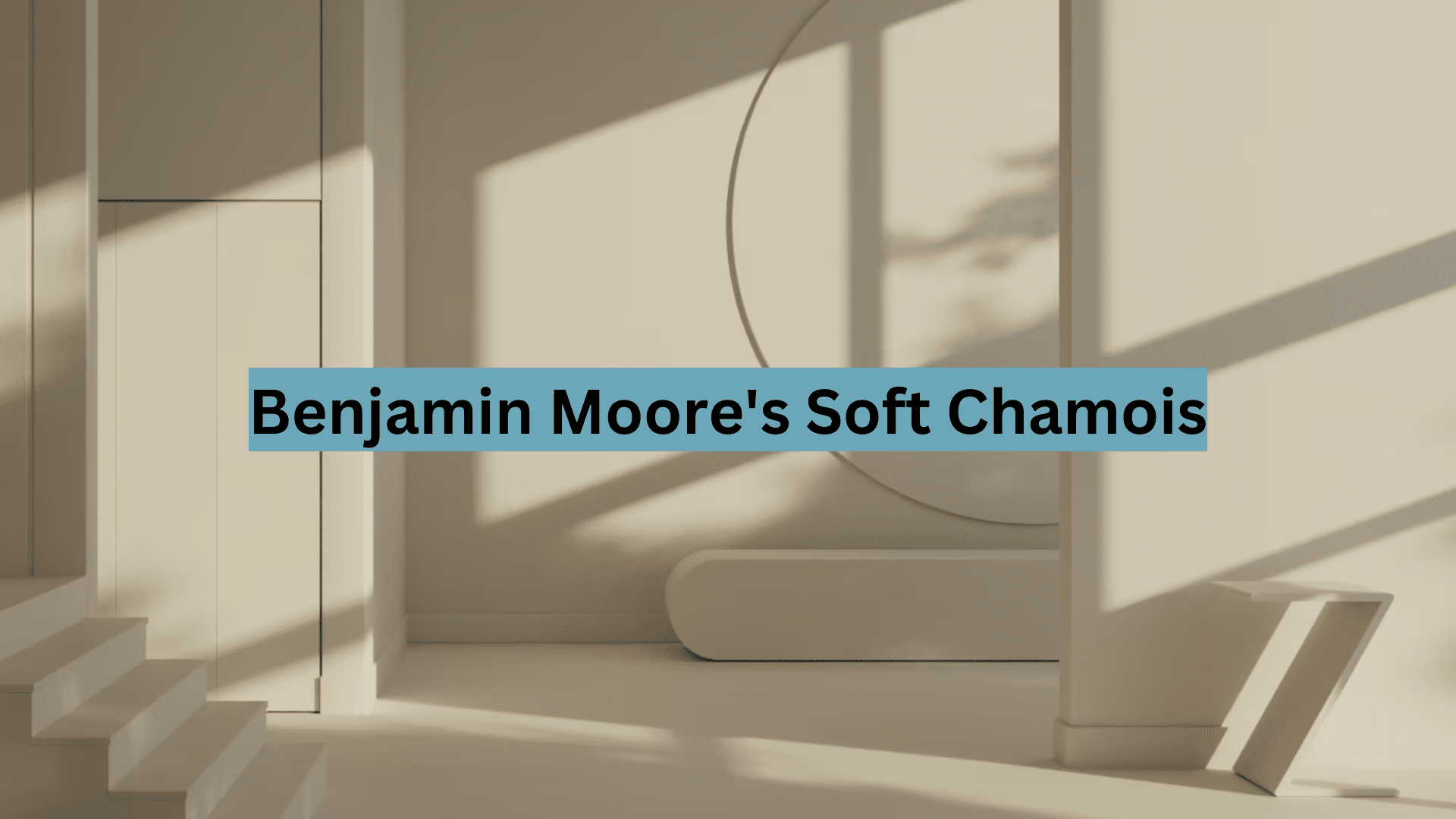My search for the ideal neutral paint color seemed to never end. After testing more paint samples than I can count, I finally found Benjamin Moore Soft Chamois. This color changed the way my entire home feels, and I’m excited to share everything I’ve learned about it with you.
As someone who’s painted three rooms with Soft Chamois in different lighting situations, I can help you avoid costly mistakes. My guide will show you exactly what this Benjamin Moore color looks like, where it works best, and how to use it in your home.
I’ll cover:
- What makes Soft Chamois special
- Which rooms it works best in
- Colors that match perfectly with it
- How to test it before buying gallons of paint
Let’s see if Soft Chamois is the right choice for your space.
What Kind of Color Is Soft Chamois (OC-13)?
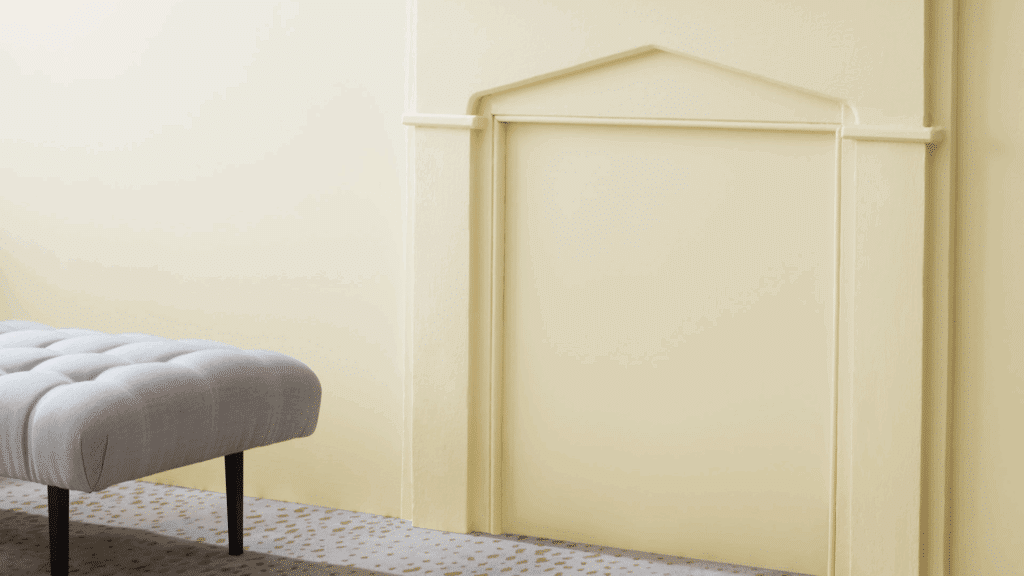
Soft Chamois (OC-13) is a warm, creamy neutral with subtle beige undertones. It sits in the “Off-White Collection” of Benjamin Moore paints. Not too stark or yellow, it has just enough warmth to feel cozy without being heavy. I think of it as the color of fresh cream with a hint of sunshine.
I’ve noticed it shifts throughout the day. In morning light, the creamy tones become more visible. By evening, it takes on a slightly warmer glow, creating a welcoming atmosphere.
The color has an LRV (Light Reflectance Value) of 77.4, placing it in the light range. This means it bounces back a lot of light while maintaining enough substance to look like an actual color rather than plain white.
What makes Soft Chamois stand out is how it adapts to its surroundings. In some spaces, it appears more beige, while in others, the creamy aspects become more noticeable. This subtle variation helps it work in many different settings and with various decor styles.
What Rooms Work Best with Soft Chamois?
Soft Chamois (Benjamin Moore OC-13) is a versatile warm neutral with subtle yellow undertones that creates a cozy, inviting atmosphere in many spaces throughout the home. Let’s see the rooms where this beautiful color truly shines:
Living Rooms
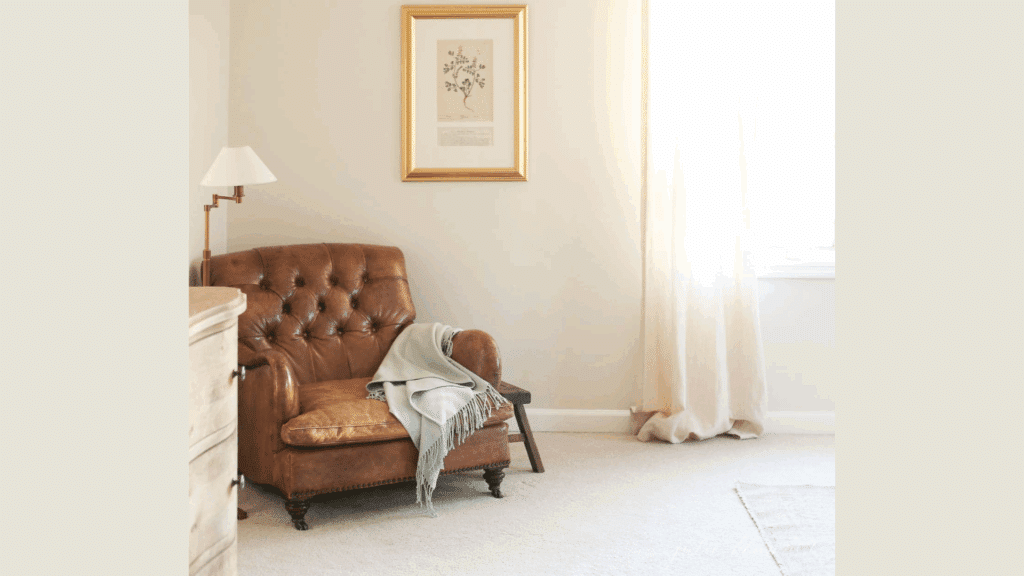
This color makes living areas feel warm and inviting without being too bold. It creates a neutral background that lets your furniture and art take center stage.
In my living room, Soft Chamois walls make the space feel larger and more open while complementing both my brown leather sofa and blue accent chairs.
Dining Rooms
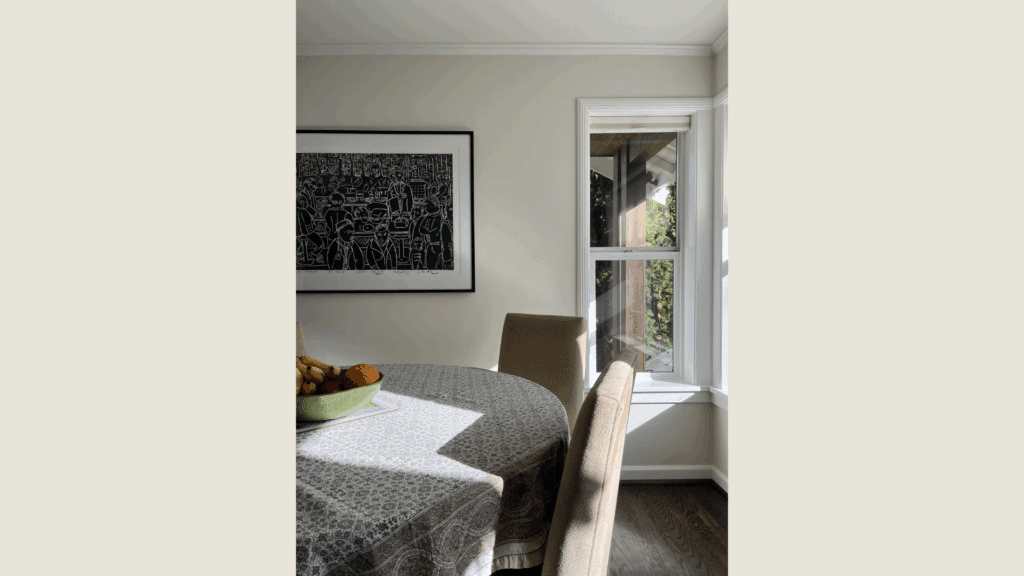
Soft Chamois adds a sense of warmth that makes meal times feel more special. It looks amazing in candlelight, taking on a golden glow that makes everyone look their best. My dining room walls painted in this shade create the perfect backdrop for family dinners and special occasions.
Kitchens
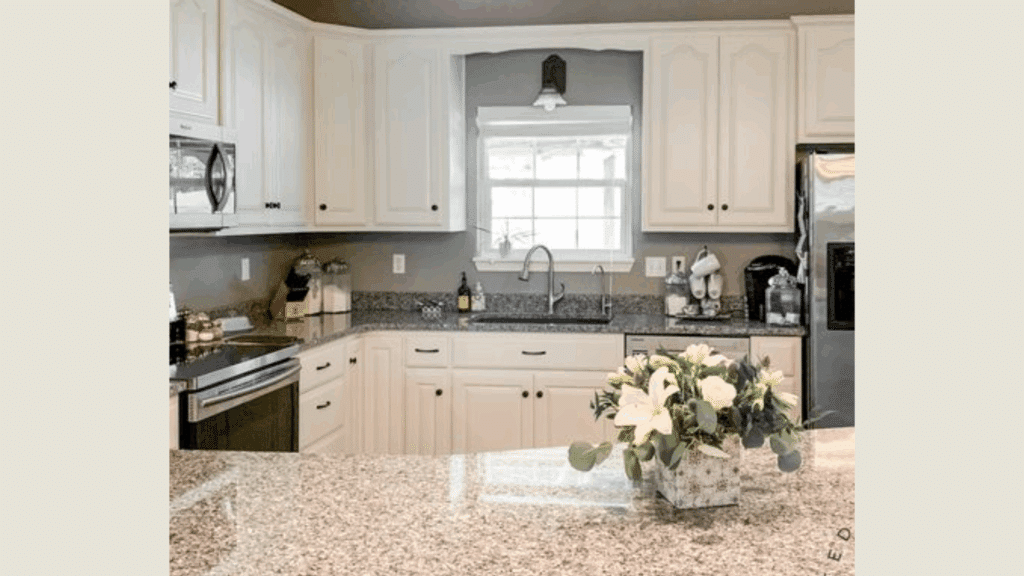
This color works with both light and dark cabinets. The subtle warmth balances cool countertops like marble or quartz. My friend painted her kitchen Soft Chamois with white cabinets and dark hardware, creating a clean but not cold cooking space.
Bedrooms
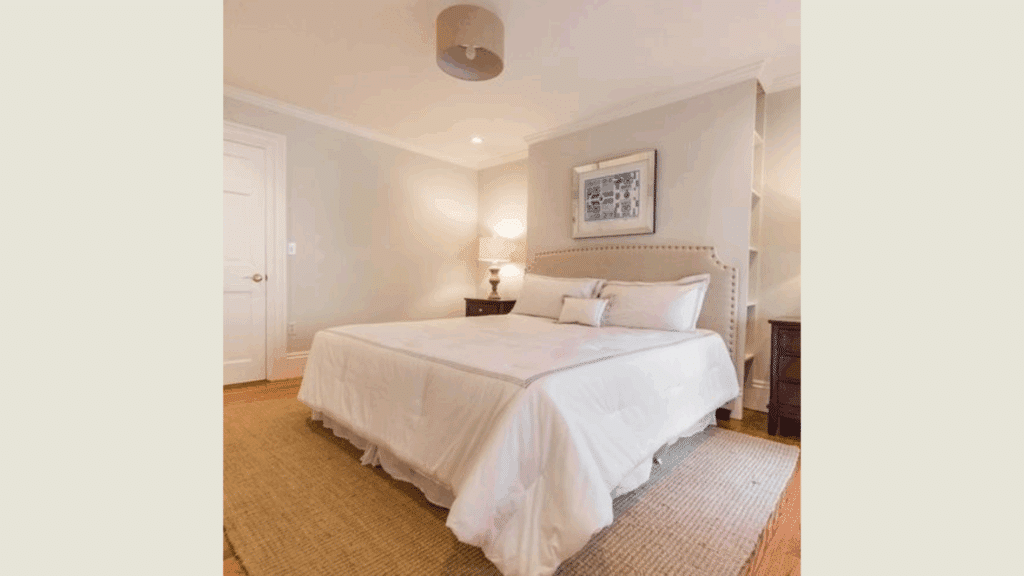
The warm, neutral tones make bedrooms feel restful and cozy. This color creates a calm background that promotes sleep. In my guest bedroom, I paired Soft Chamois with natural linen bedding and wooden furniture for a hotel-quality retreat that visitors love.
Home Offices
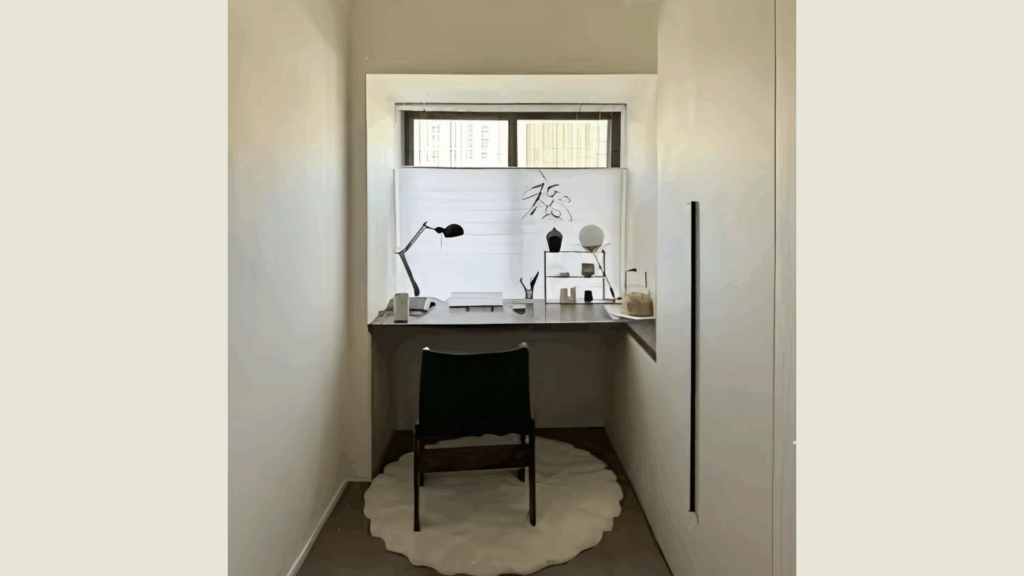
The color helps create focus without being boring or distracting. The neutral warmth feels professional yet comfortable for long workdays. I painted my home office in this shade and find it creates the perfect background for video calls while keeping me productive throughout the day.
What Colors Go Well with Soft Chamois?
Soft Chamois pairs beautifully with many colors. Here are my top matches:
- Deep blues: Navy or indigo create stunning contrast
- Greens: Sage or olive greens complement the warm undertones
- Wood tones: Both light and dark woods look natural next to this shade
- Crisp whites: For trim and ceilings to create definition
- Charcoal gray: For a modern, grounded look
For my entry hall, I combined Soft Chamois walls with white trim and dark wooden furniture. The combination feels both fresh and timeless.
What Style Works Well With This Color?
Soft Chamois adapts to many design styles, which explains why it remains so popular. In traditional homes, it highlights architectural details and classic furniture without competing for attention.
For farmhouse style, it adds warmth while maintaining the clean, simple aesthetic that defines the look. In modern spaces, it softens hard edges and minimalist furniture, adding necessary warmth.
Perhaps most impressively, Soft Chamois excels in transitional homes by connecting traditional elements with contemporary pieces.
My own home mixes vintage finds with newer items, and this color creates the perfect neutral canvas for both. This flexibility makes it a safe choice if you like to change your decor or mix pieces from different eras.
Is It a Warm or Cool Color?

Soft Chamois is definitely a warm color. Its creamy beige undertones give it that cozy feeling, but it’s not overly yellow or orange. I’d describe it as “softly warm”—not the kind that makes a room feel stuffy or dated.
The subtle warmth adds comfort to any space while avoiding the starkness of cooler neutrals. This balance makes it work year-round in most homes.
| Characteristic | Soft Chamois | What This Means For Your Space |
|---|---|---|
| Temperature | Warm | Creates a cozy, welcoming atmosphere |
| Undertones | Creamy beige | Adds warmth without looking yellow |
| Light Reflectance Value | 77.4 | Light enough to make spaces feel open but not stark white |
| Seasonal Feel | Year-round | Works well in both summer and winter settings |
| North vs. South Rooms | Adaptable | Appears creamier in south-facing rooms, more neutral in north-facing rooms |
How to Test This Color in Your Space?
This step is crucial! Here’s my testing method:
- Buy a sample: Get a small container of Soft Chamois
- Paint a board: Use a 2×2 foot piece of poster board
- Move it around: See how it looks in different locations at different times of day
- Live with it for 3 days: Your initial impression might change
When I tested Soft Chamois, I was surprised by how different it looked from morning to evening. In my north-facing office, it appeared more neutral. In my south-facing living room, the warm tones were more noticeable.
What Paint Finish Should You Choose?
- Flat: Good for ceilings and low-traffic areas
- Matte: My top choice for most walls – conceals imperfections well
- Eggshell: This works in kitchens and bathrooms where you need to clean walls
- Satin: Adds a slight sheen, good for trim with this color
- Semi-gloss: Too shiny for Soft Chamois walls, but works for doors and window frames
I used matte in my living room and eggshell in my kitchen. The eggshell finish makes cleaning easier without adding too much shine.
Real Home Ideas Using Soft Chamois
I’ve gathered these ideas from my own home and friends’ houses:
- Whole-house color: Soft Chamois creates flow between rooms
- Trim and doors: Paired with a darker wall color for subtle contrast
- Furniture: A bookcase or sideboard painted this shade
- Exterior: Body color with white trim for a classic look
- Ceiling: Painted in Soft Chamois with white walls for warmth overhead
My neighbor painted all her walls Soft Chamois with crisp white trim, creating a cohesive backdrop for her colorful art collection. It looks amazing and has inspired me to think about using it in more areas of my home.
Mistakes to Avoid
- Using cool white lighting with Soft Chamois – LED bulbs above 4000K make this color look flat and dull. Stick with warm white bulbs (2700-3000K) to enhance its natural warmth and creaminess.
- Pairing with bright white instead of soft white – Stark whites make Soft Chamois look dirty or too yellow. For trim and ceilings, it seems best with softer whites like Benjamin Moore’s White Dove or Swiss Coffee.
- Not testing in your actual space – This color changes with lighting conditions. I was surprised how different it looked in my north-facing bedroom versus my south-facing living room. Always test a large sample in your own space.
- Using only beige accents – This creates a room that feels bland and one-dimensional. Mix in other colors like blues, greens, and even hints of terracotta for depth and interest.
- Expecting it to look exactly like online photos – Every screen displays colors differently, and professional images are often edited. The only way to know how it will look in your home is to test it yourself.
Why People Like Soft Chamois?
Soft Chamois has become a go-to color for many homeowners, and I can see why. Its unique balance of warmth and neutrality creates a versatile shade that feels both classic and current. People love it because it’s not a typical beige – it has depth and subtlety without being hard to use.
The color creates warm spaces that still feel clean and fresh. It works with many decorating styles and doesn’t date quickly like trendier colors might.
Whether in natural or artificial lighting, it maintains its character while shifting subtly throughout the day, keeping spaces interesting. This adaptability makes it a safe choice for those who want warmth without the risk of a color feeling too heavy or yellow.
Wrap-Up: Should You Try It?
After living with Soft Chamois for years, I can honestly say it’s worth considering for your home. This color hits the sweet spot – enough warmth to feel cozy but neutral enough to live with every day.
What makes it special is its ability to work in almost any room and with most decor styles. It’s one of those rare paint colors that looks good in both morning and evening light.
Before you commit, remember these three things:
- Test a sample in your actual space
- Look at it during different times of day
- Consider how it works with your existing furniture and finishes
I still feel happy when I walk into my Soft Chamois rooms. That lasting satisfaction is the true test of a great paint color choice.
Frequently Asked Questions
Is Soft Chamois Too Beige for A Modern Home?
No, it’s actually a subtle, creamy neutral. Most people find it clean and fresh in modern spaces, adding the necessary warmth to balance cool elements.
Does Soft Chamois Work with Gray Furniture?
Yes! Soft chamois’s warm tones beautifully balance cooler grays, creating a balanced look that feels current and comfortable.
Will Soft Chamois Make a Small Room Look Bigger?
It can! Its high light-reflectance value helps bounce light around, opening up small spaces, especially when paired with similar trim and ceiling colors.
Can I Use Soft Chamois in North-Facing Rooms?
Yes, but expect it to look more neutral than warm. In north-facing rooms, it creates a soft, balanced atmosphere rather than a very warm feel.
How Does Soft Chamois Compare to White Dove?
Soft Chamois has more warmth and beige undertones, while White Dove is a softer white with less color. Soft Chamois has a slightly lower LRV, making it more noticeable as an actual color on walls.

